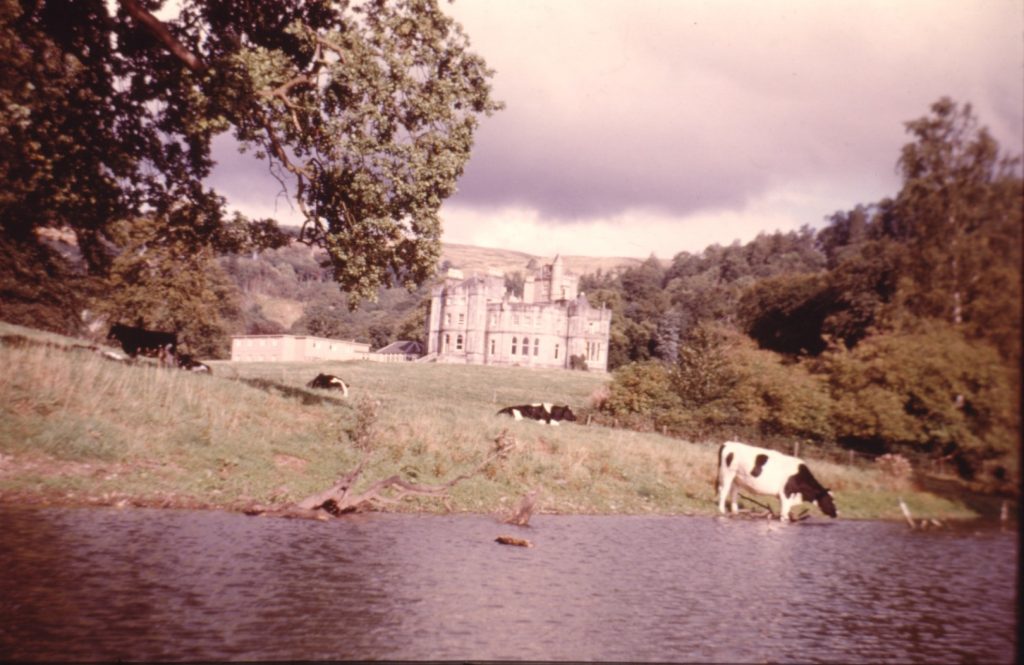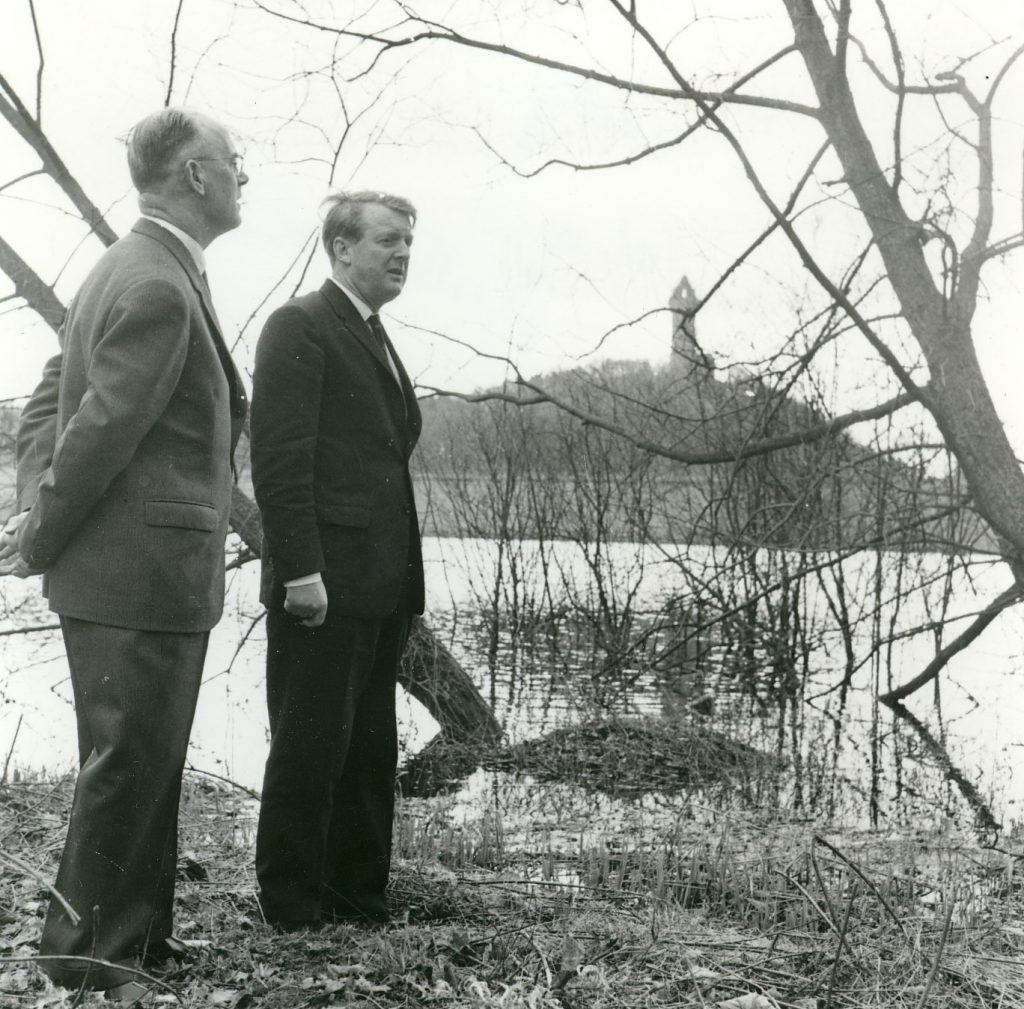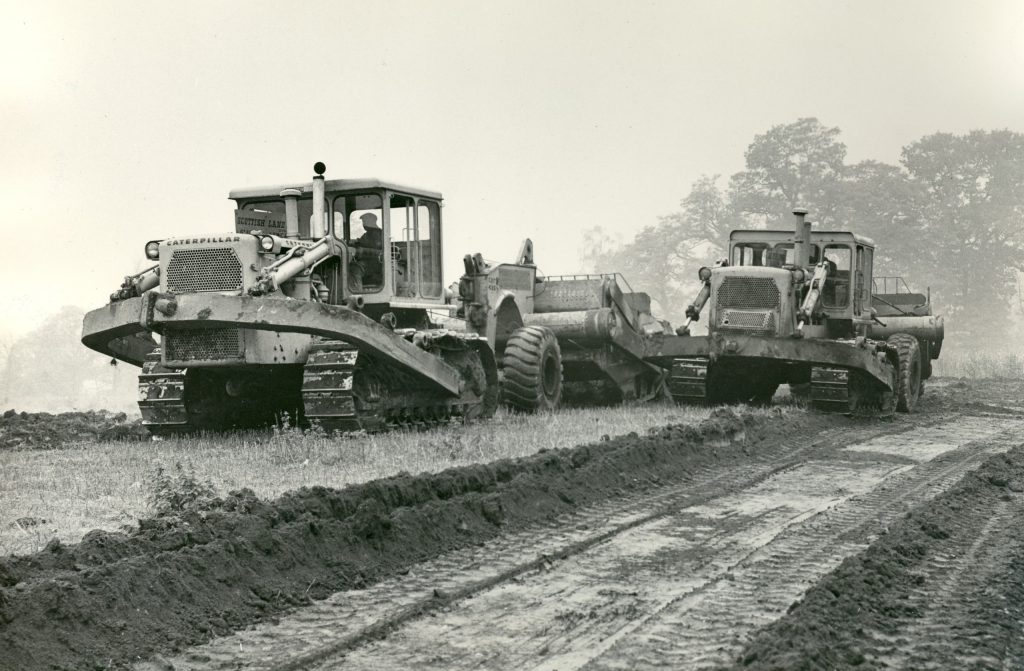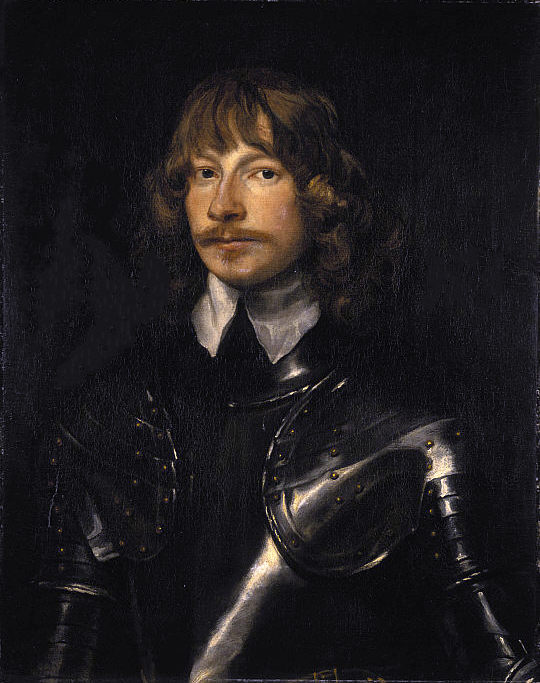A BRIEF HISTORY OF THE UNIVERSITY OF STIRLING CAMPUS

The area that we now know as the University of Stirling campus is in fact part of a very old estate. Over the centuries its ownership passed through the hands of a variety of aristocratic Scottish families, at least four houses were built here, and this land has witnessed many changes in Scottish history.
Perhaps you have seen one of the standing stones around campus – near Pathfoot or on the sports field? They are ancient markers of some kind – some say of a battle waged by legendary leader Kenneth Mac Alpin, in the 9th Century – but most likely they are much older – prehistoric stones, with a significance long forgotten. Legend also refers to Saint Servanus (or Serf) who in the 6th Century was said to have cured King Bridei of the Picts of a deadly disease in a ‘miracle of Athran’: one of the first references to Airthrey.

Ethra is in the centre, to the right of the road.
The first written mention of an estate here – named ‘Ethra’ on old maps– is in one of the many charters granted in the mid 12th Century by King David I. The name was subsequently also written as Athra and Aithrie before it finally became Airthrey. Early references suggest that in medieval times the lands here belonged to the local monks of Cambus, Kenneth & Dunfermline. (Nearby Cambuskenneth Abbey, built in 1147, would have been one of the wealthiest in Scotland, due to its proximity to Stirling Castle).
In 1370, the Airthrey estate was granted to Sir John Herice, Keeper of Stirling Castle.
Then the land passed to the Graham family.
Graham (Montrose) Family 1488-1678 (owned the Airthrey estate for 190 years)
In the 15th Century, the Airthrey estate was granted to William, 3rd Lord Graham of Kincardine who later died alongside his king (James IV) at the famous Battle of Flodden against the English on 9th September 1513. (The loss of the king and a large proportion of the Scottish nobility that day led to a political crisis).
The first written reference to a manor house existing at Airthrey was when it was reported burnt down by Covenanting troops, probably in 1648, as a reprisal for James Graham, 1st Marquess of Montrose’s support for the Royalists in the Scottish civil war (1644-5).
In 1670 the lands were in possession of Sir William Stirling, but returned to the Marquess of Montrose by Charles II in 1675.
Hope of Hopetoun Family 1678-1706 (28 years)
In 1678 Airthrey became part of the expanding empire of the Hopes of Hopetoun (and in 1682, a western portion of the estate – towards Bridge of Allan – was sold to James Henderson, a local farmer, leading to the name ‘Westerton’).
Dundas Family 1716-1759 (43 years)
The Dundas of Manour family (from a nearby estate) took control of Airthrey through a property swap with Hopetoun in the early 18th Century. Ralph Dundas began to plant trees on the estate and on the hill (which became Hermitage woods). Later, John Dundas built Airthrey House, completed in 1747. The location of this house is now uncertain, but it was described in memory by a younger relative as a ‘small snug house’, and there was a kitchen garden too, though John reportedly spent most of his time here indoors ‘among his books’.
Haldane Family 1759-1798 (39 years)
John Dundas sold Airthrey in 1759 (apparently because he didn’t take to country life) to Captain Robert Haldane of Plean, a naval officer, aristocrat and Member of Parliament. He was described as ‘an arrogant, ambitious, purse-proud man’ and he diverted the ancient road from straight across the estate to around the boundary, which infuriated the locals.
The Captain died childless on Hogmanay 1767, and his great-nephew, also Robert, decided to make the estate his home when he married in 1786, commissioning the building of Airthrey Castle to a design by Robert Adam.

This is the residence that we can still see today (though now quite altered, especially from the front). Haldane’s fashionable vision for the estate drew on English influences. The grounds were landscaped by Thomas White Senior (c1736-1811). He had worked with Capability Brown, but was a much admired designer in his own right from the 1760s. He was involved c1798 in designing the man-made loch and sweeping lawns, together with copses, as was Alexander Nasmyth, a skilled painter who also advised members of the Scottish nobility in the improvement and beautification of their estates.
Eccentrically, Haldane had a hermitage built, advertising locally for a hermit to occupy it (the ruins can still be seen). He also built a summer house in the woods, and Ivy and Garden Cottage were constructed at this time too. A four-mile wall was built around the circumference of the estate.
But before it was completed, Robert Haldane sold everything in 1798 to pay for his evangelical work – setting up the Scottish Congregationalists. It was the next owner, General Sir Robert Abercromby, who completed the Castle in 1798.
Abercromby Family 1798-1889 (91 years)
Robert Haldane sold the estate to a relative-by-marriage, Robert Abercromby, who was a distinguished soldier and had been Governor of Bombay.
As well as completing the castle, he landscaped a deer park, had hunting lodges built and, most dramatically, had the village of Pathfoot entirely cleared, and also moved the inhabitants of Logie village to the new settlement of Causewayhead. Robert Abercromby was highly influential in the transformation of Bridge of Allan from sleepy village to fashionable 19th century spa town.
He had not married, and his nephew succeeded to the title and the estates in 1827. The new owner, George, 2nd Baron Abercromby, had six children and the estate then passed to his son George Ralph (1800-52) who passed it on to his son, also George Ralph (1838-1917). However, the second George Ralph sold the estate in 1889 to Donald Graham. (These Grahams were only very distantly related to the owners of Airthrey in the 15th-17th centuries)
Graham Family 1889-1939 (50 years)
The purchase of Airthrey in 1889 reflected the rise of the mercantile class in the 19th Century, in contrast with the landed gentry who had always owned the estate in the previous centuries. The purchaser, Donald Graham, came from a successful Glasgow merchant family which had made enough money to lease Skelmorlie Castle in Ayrshire and to send him to be educated at Harrow.
Under the Grahams, the castle was remodelled to house their collections such as Renaissance wood panelling, and Indian and Persian antiques and tiles, and a tower was added. Although in keeping with romantic 19th century notions of how a Scottish castle should look, this unfortunately in the process lost most of the detailing of the original 18th Century Adam design. The further landscaping of the loch and its banks was more sympathetic. An arboretum was created (still to be seen near the current golf course), after consultation with famous Scottish botanist and plant hunter George Forrest. And a bridge was built across the loch, a boat house added, and permission was granted for the Airthrey Castle curling club to use the loch which froze over regularly in winter. Donald Graham was much more involved in local life than his predecessors, and ‘each weekday morning [he] would take his single horse carriage from Airthrey Castle to Bridge of Allan station in time to catch the 8.19 to Glasgow’ *

Donald died aged only 56 in 1901 and his widow set up a Trust which remained proprietors of the estate until 1939. Airthrey Castle was then leased to the Glasgow shipping magnate Charles Donaldson, Chairman of the Donaldson Line group of shipping companies, who died at Airthrey in 1938 (the year electricity was installed in the castle)

Maternity Hospital 1939-1969 (30 years)
In 1939, after the outbreak of war, the Castle was given over by the Trust to be used as a maternity hospital, providing a safe haven mainly for Glasgow women who were most at risk from bombing raids. In 1947 the estate was sold, in part to Stirling Council, and the castle continued to be used as a maternity hospital by the brand new NHS.

In 1939, a separate Graham family took up long-term tenancy on the Airthrey Kerse Farm, the land opposite the University entrance. After the sale to Stirling Council, Graham bought the Kerse farm outright but in the 1960s agreed to sell grazing land on the main estate for the University to be built. Graham’s ‘The Family Dairy’ has since developed into one of Scotland’s largest dairy businesses.
In 1966 the Airthrey Estate was granted to the new University of Stirling and construction work began on the Pathfoot Building. Airthrey Castle continued to function as a maternity hospital until 1969 when it was also transferred to the University of Stirling, which welcomed its first students in 1967.



Sources and further reading
https://en.wikipedia.org/wiki/Airthrey_Castle
https://www.oralhistory.stir.ac.uk/memorabilia/09-10_Conservation_Plan.pdf
Archive resources stored at the University of Stirling Archive, and details of further historical accounts and publications: https://libguides.stir.ac.uk/c.php?g=530467&p=3628579
Bridge of Allan, A History (Dr Welsh Educational and Historical Trust, 2018) is a fascinating and knowledgeable work, written by Craig Mair. It is available in libraries.
*The reference to Donald Graham’s commute is quoted from this book.
Some related blog posts:
https://archives.stir.ac.uk/2020/03/26/object-of-the-week/
https://archives.stir.ac.uk/2020/08/03/art-at-the-university-the-early-days/
https://archives.stir.ac.uk/2020/07/26/garden-cottage/





